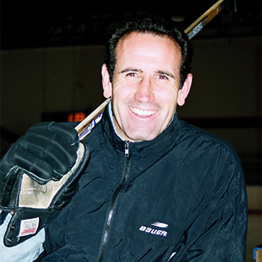Practice accelerating with 1) two hands on stick – blade off ice, 2) two hands on stick – blade on ice and 3) one hand on stick – blade on ice.
Faster skaters return the recovery skate to the ice after push-off quicker than slow skaters (Page, 1975).
Fast skaters do not bring their recovery skate back to touch the glide skate. This a characteristic of slow skating.
A “full” stride is actually impossible at high speeds where the length of the stride is determined by the quickness of returning the “recovery” skate to the ice. Full extension of the knee is only possible in speed skating when using the “clap skate.”
The quadriceps develop the largest contractile forces when extending the knee during the propulsion phase of hockey skating (Halliwell, 1978).
Electromyographic studies of speed skaters show that the vastus medialis and vastus lateralis have the most “activity” during the propulsion phase of skating (Kumamoto, et al. and Mashima, et al.).
Minimize vertical movements with skates and practice fluid horizontal movements. Vertical movements are characteristic of novice skaters, and can be considered a performance decrement (Marino, 1984).
The correct shoulder (arm) movement for high performance skating is “side to side.”
The sinusoidal (wave-like) pattern of skating causes the propulsion skate to push to the side. When the leg pushes to the side the equal and opposite reaction is the shoulder (arm) moving to the side.
Observation of high performance hockey players clearly reveals a side to side shoulder (arm) movement is used during straight skating/striding.
Shoulder (arm) movement appears to be an important characteristic of high performance skating. A lack of coordination between the movement of the shoulders (arms) and the legs causes a performance decrement in young hockey players.
Skating performance may be enhanced when players practice skating with specific teaching cues to “move the arms with the legs.”
Observation of forward and back (shoulder flexion/extension) shoulder movement shows that it causes a narrow stride. A narrow stride is characteristic of low performance skating.
Hockey players can only maintain shoulder flexion-extension during “power skating” instructional activities for one – three strides, after which they assume a natural skating pattern of shoulder abduction/adduction (side to side).
Practice striding with 1) two hands on stick – blade off ice, 2) two hands on stick – blade on ice and 3) one hand on stick – blade on ice.
Bracko (1998) found that NHL forwards spend 40% of the time on the ice gliding in a two foot balance position, interspersed with left and right turns. The gliding is not sustained rather, the average length of time spent in a skating characteristic is 1.5 seconds (Bracko, 1998).
Good balance position to be ready for acceleration, body contact and/or puck contact (stick close to , but not necessarily on, the ice). Observation of elite players shows they rarely have the blade of the stick on the ice when skating without the puck. Insistence by coaches and instructors for their players to maintain the blade of the stick on the ice can cause extreme fatigue in the back extensor, gluteus maximus (butt muscle) and the quadriceps. This fatigue can retard learning and performance.
Isometric contractions of the quadriceps may cause fatigue. This means that hockey players (especially young hockey players) cannot maintain the “ready” position for an extended period of time during practice.
To assist unskilled players in performing two tasks simultaneously, the attention demands of one task must be reduced, i.e.: puck handling while concentrating on skating (Leavitt, 1979).
The weight must be on the outside skate to maintain balance. Centrifugal force will “pull” the body away from the turn, therefore the outside skate maintains the centripetal force pulling the player into the turn.
If weight is placed on inside skate, it will cause the player to slow or stop, which can be used only as a high performance maneuver when slowing or stopping.
Young hockey players must be taught to maintain most of weight of the body on the outside leg, otherwise poor balance will cause the player to fall.
High performance players can execute a “slowing turn” by placing pressure on inside skate (slowing or turning by using the outside edge of the inside skate). This execution is only performed when the player wants to slow down or slow and turn at the same time.
Maintain “Ready Position” going into and coming out of turn.
Lean into stop.
One foot stop. High performance stop used by elite players. Enhances ability to accelerate out of stop. Back knee straight, front knee bent.
High Speed Inside Foot Slowing Technique.
Used as a high performance technique to slow down or change directions, but not necessarily to stop. Forward skate is externally rotated (turned to the outside). Most of weight is on back knee which is bent. Pressure is put on outside edge of front skate to slow.
Forward skate is externally rotated (turned to the outside). Most of weight is on back knee which is bent. Pressure is put on outside edge of front skate to slow.

Hockey Institute – All Rights Reserved – Calgary Web Design by Blue Ocean